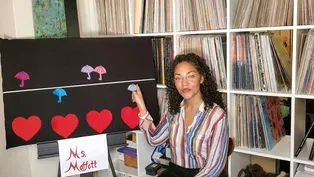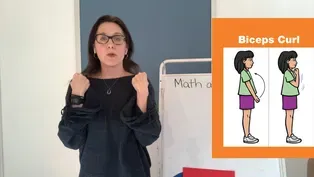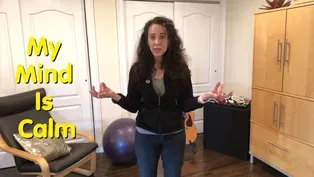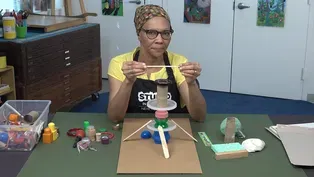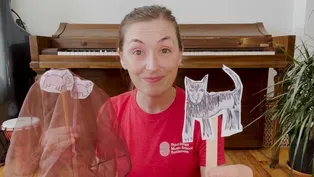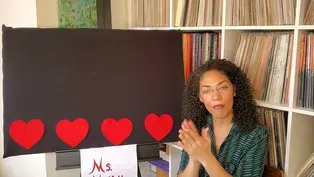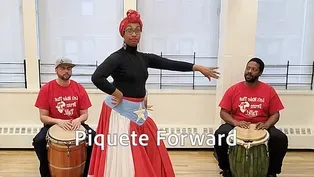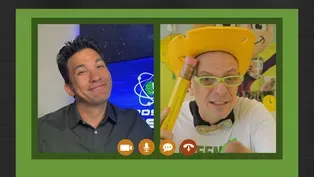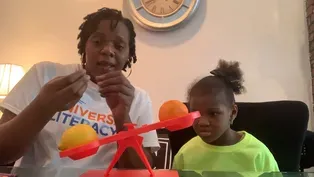
What Sounds Do You Hear in Class?
2/17/2021 | 57m 13sVideo has Closed Captions
Learn how citizens can change laws, sing about the letter M, read MAMA, LOOK!
Learn how citizens can change laws, sing about the letter M, read MAMA, LOOK!, explore ways to make 10, review double consonants. LET’S LEARN helps children ages 3-8 with at-home learning. One-hour programs feature instruction by educators and virtual field trips.
Problems with Closed Captions? Closed Captioning Feedback
Problems with Closed Captions? Closed Captioning Feedback
Let's Learn is a local public television program presented by THIRTEEN PBS

What Sounds Do You Hear in Class?
2/17/2021 | 57m 13sVideo has Closed Captions
Learn how citizens can change laws, sing about the letter M, read MAMA, LOOK!, explore ways to make 10, review double consonants. LET’S LEARN helps children ages 3-8 with at-home learning. One-hour programs feature instruction by educators and virtual field trips.
Problems with Closed Captions? Closed Captioning Feedback
How to Watch Let's Learn
Let's Learn is available to stream on pbs.org and the free PBS App, available on iPhone, Apple TV, Android TV, Android smartphones, Amazon Fire TV, Amazon Fire Tablet, Roku, Samsung Smart TV, and Vizio.
Providing Support for PBS.org
Learn Moreabout PBS online sponsorshipMore from This Collection
Video has Closed Captions
Read SCHOOL BUS and draw one, learn about prefixes and pitch, build sculptures. (57m 48s)
Running and Counting Both End in “ing”!
Video has Closed Captions
Move to improve, find the missing number, learn songs from Ghana, read ABUELITA’S SECRET. (58m 17s)
What Sound Does “aw” Make in Draw?
Video has Closed Captions
Read a story, discover "au" and "aw," learn about density, count, and move with music. (56m 58s)
Can You Find the Short “u” in Subtract?
Video has Closed Captions
Help Super Grover 2.0 solve a prickly problem, read ALL THE WAYS TO BE SMART. (56m 19s)
What Sound Does “gl” Make in Glove?
Video has Closed Captions
Play the glockenspiel, help Super Grover 2.0 make a cart move, read TWO WOOL GLOVES. (58m 9s)
Incredible Starts with Short “i”!
Video has Closed Captions
Solve problems with Super Grover 2.0, catch a rainbow, hear a piano sound like a cuckoo. (56m 9s)
What’s the Sound of “oo” in Book?
Video has Closed Captions
Explore animals’ form and function, sing about the 3 little pigs, read THE LITTLE BOX. (58m 15s)
We’re Reducing, Reusing and Recycling!
Video has Closed Captions
Learn all about rhythm and the number 9, read A BAG IN THE WIND. (56m 17s)
Video has Closed Captions
Learn to dance bomba and grow food in a city, read WOLF CUB’S SONG. (55m 20s)
How Many Syllables are in Invent?
Video has Closed Captions
Invent your own instrument, make 10 to add numbers to 20, read ONE GOLDEN RULE AT SCHOOL. (57m 36s)
Video has Closed Captions
Learn about the science behind mind reading, count shells, read MY BIG FAMILY. (57m 27s)
Which is Heavier: One Apple or Two Apples?
Video has Closed Captions
Defy gravity, learn secret code words for fast and slow in music, read WHOOO KNEW? (58m 5s)
Providing Support for PBS.org
Learn Moreabout PBS online sponsorship[playful music] - [Announcer] Ready to learn?
- [Both] Hi.
- [Announcer] It's time to share a story, read and write.
- Lets read it back, - [Announcer] Discover science, sing.
♪ Somewhere ♪ - [Announcer] Play and so much more.
- Cupcake!
- Very good.
- [Announcer] Stay tuned for lessons and activities.
- We're gonna start making some words.
Isn't that fun?
- Mm-hmm.
- [Announcer] Funding for this program was provided by The JPB Foundation.
- Hi, everyone, how are you doing today?
My name is Katherine Rodriguez-Aguero, and I'm so excited to share with you this new story today.
So the title of this new story or the title of this book is called "Mama, Look!"
And this story is by Patricia J. Murphy and David Diaz.
So in this wonderful story, we're going to be taking a walk and the characters in this book are going to be exploring through this walk.
Now, what I want you to do at home is also follow along with the pictures in the story, follow along with what they're seeing and what they're doing, and tell me what are some images that you see?
So I want you to think about what are some of the images, some of the pictures, the animals, the creatures that you are seeing along with the characters in the story.
Afterwards, we have a quick activity that we're gonna do with just a piece of paper and a marker.
If you have crayons too, that works as well.
Are you ready?
Okay, let's start.
"Mama, Look!"
[gasps] Look at these beautiful colors.
"Mama, Look!"
by Patricia J. Murphy and David Diaz: Mama, look!
[gasps] Can you see all the wonderful things that they're looking at?
What are some of the pictures that the boy or some of the things that the boy might be seeing?
Flowers?
Did you say flowers?
Yes.
I agree.
Look at the beautiful colors of these flowers.
Wow!
Grasshoppers.
[gasp] So beyond the flowers, there were these tiny little insects, grasshoppers, and look at them eating the leaves over here.
So wonderful.
We can see their arm, their legs.
Wow.
Their eyes and their antenna.
Mama, look!
Hmm, wonder what we're gonna see next.
Ants!
[gasps] Wow, look at the ants!
The ants are eating from the leafs.
They're carrying them.
Mama, look!
Butterflies.
Wow, does this butterfly have some of your favorite colors?
This butterfly has the color purple.
I love the color purple.
What is your favorite color?
Mama, look!
[gasps] Oh my goodness.
What do you this could be?
A frog?
Let's see, maybe you're right.
Frogs.
Mama, look!
Look at the tadpoles, and they're swimming, and the frog.
Let's see, I wonder what this could be.
Are you ready?
Let's turn the page Fish.
Yes, that makes sense.
Fish are underwater as well.
What makes fish so unique?
Can you tell me a little bit about that?
Oh, you see gills and fins?
I see gills and fins too.
I also see bubbles coming out of their mouths are being made.
Mama, look!
I think we know what animal that is.
You said ducks?
Good job.
Ducks.
Mama, look!
Wow, I wonder what's going to come next.
Turtles.
Look at these wonderful turtles.
They're green.
They have their shells.
Don't they look so wonderful?
And it makes me think about all of the animals that we might see when we go outside, or even all the plants that we might see when we go outside.
Take a look.
Next time you're outside, maybe at a pond or maybe at a park, or outside in your backyard, you may find some very interesting creatures or even plants as well.
Mama, look!
What is living under there?
Bunnies, look at those bunnies.
Can you count how many bunnies there are?
Count with me.
Are you ready?
One, two, three, four, five, six, seven, eight, nine.
Wow.
Nine bunnies.
Great work.
And here we see the turtle, the turtle from the previous photo, looking down.
Wow, these are bunnies.
And look, this bunny sees something else.
Mama, look!
I wonder what the bunny's gonna see.
[gasps] Puppies!
Do you like puppies?
I do too.
Puppies.
Wow.
What are the puppies doing?
Yes, you're right.
We have a curious puppy looking down a hole over here.
We have this puppy trying to look at what's above the tree.
Mama, look!
Something fell from the tree.
What could it be?
It looks like a little nut or some kind of acorn.
Maybe a seed.
I wonder how it fell.
Let's see.
Squirrels, oh those squirrels.
See one of their acorns fell, and it went boop on the puppy's nose.
Mama, look!
Let' see.
What is this squirrel seeing?
I wonder what this squirrel's looking at.
Oh my goodness.
Opossums.
Opossums.
Do you know what an opossum is?
These animals are called opossums.
And it's a family of opossums.
We have one, two, three, four, five, six baby opossums.
Mama, look!
Birds.
Not just any birds.
Do you know what kind of birds these are?
Did you say blue jays?
Yes.
You're right.
These birds are called blue jays.
Very good.
And here we have the mama coming with some berries to drop them off to the baby blue jay birds.
How many baby birds do you see?
Ready?
Let's count the babies.
One, two, three.
Aw, yeah, the mama's bringing some berries and some foods to the babies.
Mama, look!
Bees.
We see some bees.
Where are the bees located?
It looks like they're inside of their hive, their beehive.
Wow.
So many bees.
Hey, do you want to count the little bees with me?
Yeah?
Okay.
One, two, three, four, five, six, seven, eight, nine, 10, 11, you're right.
There are 11 little bees.
12 if you count the mama as well.
Mama, look!
Okay, friends, I'm going to give you some time.
What do you think those fingers could be?
They look very familiar to me.
Did you say hands?
You're correct.
They're fingers that belong to a human hand.
Let's see if we were right.
[gasps] We were right.
They belong to the baby.
Baby.
There is a baby behind the mama's back.
"Mama, look!"
says the baby.
So so many things were happening in this story.
There was the boy looking, and they were looking all throughout the story they were looking at all the amazing features and all the insects that they were finding, the animals.
There was so much imagery, so many beautiful imagery.
So this reminds me of when I go for a walk to the park, or when I go outside, I see a lot of beautiful things.
So you can kind of see.
This is how it ends.
It has beautiful pictures as well.
So when I go outside, I see a lot of beautiful things.
I see the sky that's so blue and bright.
I see insects and animals climbing on trees, squirrels.
Sometimes I see pigeons.
I also see different kinds of people in the street as well.
So what I want you to do today, and I'm wondering if you can tell me, is in your piece of paper, and if you have a marker, great, make sure you have a marker, a crayon, a pencil.
It could be anything that you have at home.
I want you to take a walk, or even just look outside your window, and see what are some things that you can find outside.
If I were to look outside the window, what could I see?
Hmm, and if you look close enough, would you be able to see anything else?
Take some time to draw those pictures of what you can see.
I'm so excited for you to share this with me.
For example, if I look outside my window now, I see decorations, and maybe I could even draw these different kinds of decorations.
I also see some squirrels on my tree, so I'm going to draw a tree.
Here's my tree.
And I'm also going to draw the squirrel I see.
So I bet you're so much better drawers.
We're all really good drawers, but I'm sure you're a great artist.
So here I have my squirrel that I see outside, and a tree.
If you want an extra challenge, I recommend that you even write down the word, so I'm gonna write down the word tree, and I'm gonna write down squirrel, okay?
So see if you might want to do that as well.
If you want to give yourself an extra challenge.
I'm so excited to see what are the wonderful things that you see outside eat when you go outside, or even outside your window.
Explore away.
And I hope you have a great rest of your day.
Bye!
- Hi, movers and shakers.
This is Violet.
And today we have some special guests.
My cousins Liam and Aiden are gonna help us sing a song called "Rattlin' Bog."
They're gonna sing the call, and I'm gonna sing the response.
That means they're gonna say something, and I'm gonna repeat after them.
Can you help us sing this song together?
Great.
All right.
♪ Ho ro the rattlin' bog ♪ ♪ Way down in the valley o ♪ ♪ Oh ro the rattlin' way bog down in the valley o ♪ - And in that bog.
♪ And in that bog ♪ - There was a tree.
♪ There was a tree ♪ ♪ A rare tree ♪ ♪ A rare tree ♪ ♪ A rattlin' tree ♪ ♪ A rattlin' tree ♪ ♪ And the tree in the bog, and the bog down in the valley o ♪ ♪ Oh ro the rattlin' bog way down in the valley o ♪ ♪ Oh ro the rattlin' bog way down in the valley o ♪ - And on that tree.
♪ And on that tree ♪ - There was a branch.
♪ There was a branch ♪ ♪ A rare branch ♪ ♪ A rare branch ♪ ♪ A rattlin' branch ♪ ♪ A rattlin' branch ♪ ♪ And the branch in the tree ♪ ♪ And the tree in the bog ♪ ♪ And the bog down in the valley o ♪ ♪ Oh ro the rattlin' bog way down in the valley o ♪ ♪ Oh ro the rattlin' bog way down in the valley o ♪ - That was so much fun.
Thanks Liam and Aiden, thanks everyone!
[playful music] - Hello scholars, welcome to a wonderful day of learning!
My name is Anna, and I am so excited to be working with you all today.
We are going to have so much fun.
First, we're going to practice isolating and segmenting phonemes, which are just sounds in words.
Then we're going to do a blend and reading activity.
That's when we're going to use our sound by sound blending routine to read some words.
Are you ready to start?
Let's begin.
Let's wake up our ears by doing an activity where we are going to identify the beginning sounds we hear in words.
So for example, I'm gonna show you some pictures.
We're gonna identify what the picture is, and then we're going to figure out what that initial sound, that very first sound is that you hear.
So for example, take a look at this picture.
This is a picture of a pool.
Say the word pool.
Now, what's the first sound that you hear in the word pool?
Well, I hear the puh sound.
So puh is the beginning sound in the word pool.
How about this picture?
What is this?
That's right.
It's a bed.
Well, what's the first sound, or the initial sound that you hear in the word bed?
That's right.
You hear the buh sound.
Everyone repeat after me buh, bed.
Awesome.
How about this?
This is a picture of a bell.
What's the first sound you hear in the word bell?
That's right, buh, you hear the buh sound at the beginning of the word bell.
Okay.
How about this picture?
Ooh, my favorite thing.
It's a book.
What's the first sound you hear in the word book?
Good job.
That's right.
Buh again for the win.
Everyone say buh, buh, book.
Great.
All right.
How about this picture?
That's right.
This is a fork.
What is the first sound you hear in the word fork?
That's right, ff.
Notice how my lip kind of tucks underneath my teeth to make that ff sound in fork.
Okay.
How about this picture?
That's right.
This is a pen.
What's the first sound you hear in the word pen?
That's right.
Puh is the first sound you hear in the word pen.
Okay.
How about this picture?
That's right.
This is the moon.
So what's the first sound you hear in the word moon?
That's right, the mm sound.
Notice how my lips are together to make that mm sound.
Okay.
Last picture.
What is this a picture of?
Yeah, this is a mule.
Okay.
Say mule.
All right, what is the first sound that you hear in the word mule?
That's right.
The mm sound.
Perfect job.
All right, now let's try segmenting some sounds in words.
Now, in order to do this, when you work with your teacher, you'll probably do this one of three ways.
Some of you might use something called a chop to break up words into their individual sounds.
Some of you might use a tap routine where the beginning sound is at your shoulder, the middle sound is at your elbow, and the last sound is at your wrist.
Others might use a finger tap where the first sound is represented by your pointer finger, then next next sound or middle sound is that next finger, And then the last sound you hear is your third or ring finger.
Use whichever strategy you use at school.
I'm gonna use tap because my first graders love to use the tapping method.
Okay, so let me show you what we're gonna do.
I'm gonna say one of our awesome picture words that we were just working on for the initial sound, but this time I want us to break it apart into each individual sound.
So for example, if I said the word bed, I would break up that word into the sounds I hear.
Buh, eh, duh.
Okay?
Now, for those of you that are using the arm tap, you'll hear the same sound.
Buh, eh, duh, okay?
[taps] And those of you that like the chop.
Buh, eh, duh.
So no matter which method we use, we're still breaking up those words into those individual sounds.
Are you ready?
Okay, let's go.
How would you break up the word bell?
Great.
Buh, eh, ull.
How about the word moon?
Good.
Mm, ooh, nn.
How about the word pool?
Great.
Puh, ooh, ull.
How about the word book?
Right.
Buh, ooh, kuh.
All right, how about the word fork?
Great.
Ff, or, kuh.
All right, last one.
How about the word mule?
Good.
Yeah.
This is a tricky one, but mm, you, ull.
Mule.
Great job, scholars.
Let's go on to our blend and read activity.
Now, before we do that, though, we need to review some sounds first.
So in school, you may have already learned that the letter C represents the kuh sound.
You probably also learned that the letter K represents the kuh sound, Today, we're gonna focus on the kuh sound at the end of a word where there's a short vowel.
When we hear that kuh sound at the end of a word where there's a short vowel, we're going to use ck together to represent that kuh sound, okay?
So if we were using our sound by sound blending routine, and we were trying to blend this word, notice my ck is going together because they're going to represent one sound.
This is called a digraph.
When two letters make one sound together.
So I would go, ss oh kuh.
Then I would blend the first two sounds together.
Soh kuh.
And then finally I would blend all three together.
Sock.
Okay?
So repeat after me.
C, K, sock, kuh.
Okay, so that's the first sound we're gonna be focusing on.
Now, the other one is called, and you may have heard it, you call it the doubling rule, okay?
So whenever we see one of these letters at the end of a word that's one syllable and there's a short vowel there, we're actually going to double these letters.
So it's the doubling rule.
F, L, S, and Z often double after a short vowel in a one syllable word.
So for example, if I had this word, and I were going to use my sound by sound blending to do this, I would say puh uh ff.
Notice, I'm not going to say ff ff, okay?
They're going to go together to make that one sound.
So puh ff all together is puff.
Right?
What about this word?
Once again, I'm not gonna say that sound twice.
They're gonna be said together as one sound.
So fuh eh zz.
Feh zz, fizz.
Okay, I think you're absolutely ready now to start doing our blending and reading activity.
Take 20 seconds to read through this on your own, and then we will read it through together.
[cheery music] Let's begin.
Lick, luck, back, pick, lock.
Sick, dock, fill, sack, doll.
Bed, quit, red, web, wit.
Tick-tock, clock, backpack.
Let's try these sentences.
Four sick pups went to the vet.
Will the sick duck get well?
Scholars, you did a wonderful job today.
You were able to isolate and segment sounds and words.
And you also did a terrific job with our blending and reading activity.
As you are reading books at home with a trusted adult, see if you can figure out and sound out these words as you're reading.
So when you come up to a tricky word, don't give up.
Use that sound by sound blending routine.
It'll work.
And trusted adults, when you're talking with your child, see if they can segment words into sounds with you just like we did today.
So give them a word like pat, and see if they can tell you puh ah tuh.
Or give them a word like fill, and see if they can tell you ff eh ull.
It's so much fun playing word games as a family.
Well, scholars, until next time, be safe, keep learning, and have fun.
Bye!
[playful music] - Hello learners.
My name is Trinette.
And I'm so happy to be working with you all today for our math lesson.
I have one of my daughters who will assist us with our work today.
Introduce yourself.
- Hello.
My name is Layla.
- All right, Layla, are you ready to get started?
- Yes.
- Learners, I hope that you're ready to get started as well.
For today's math lesson, we will have three activities.
Let's review what they are.
So for activity number one, we will count 10 objects and read the number 10.
For activity number two, we will practice writing the number 10 and also the word 10.
And for activity number three, we will explore different ways to make 10.
So let's begin.
You will need some materials for the lesson.
You will need either a pencil, a crayon, or a marker, something that you can write with, and a sheet of paper, a notebook, or a dry erase board.
Can you please ask a trusted adult to help you find those materials and then come back and join us.
Layla and I will count to 30, which should give you enough time to gather the materials that you need.
Are you ready to count?
- Yes.
- Let's go.
You guys go find those materials.
You have 30 seconds.
Ready, set?
Go!
- [Both] 1, 2, 3, 4, 5, 6, 7, 8, 9, 10, 11, 12, 13, 14, 15, 16, 17, 18 19, 20, 21, 22, 23, 24, 25, 26, 27, 28, 29 30.
- That was amazing.
You guys got back just in time.
So we will now begin with our first activity.
You don't need that pencil, crayon, or marker just yet, or that sheet of paper.
So put that to the side.
You know that we can count to the number 10 using our fingers.
So I want you to just make sure you don't have anything in your hands, and Layla and I are gonna show you how you can count up to the number 10 using just your fingers.
Are you ready, Layla?
- Yes.
- Let's begin.
So we have our hands.
There's nothing in our hands.
Our fingers and hands are free.
Let's begin.
- [Both] One, two, three, four, five, six, seven, eight, nine, 10.
- So I am holding up 10 fingers.
Layla, how many fingers are you holding?
- 10.
- Okay, at home, let's try with us, okay?
Get your fingers ready, your hands are free.
And I want you to count from 1 to 10 using your fingers.
Let's begin.
- [Both] 1, 2, 3, 4, 5, 6, 7, 8, 9, 10.
- What number did you count to?
10.
Awesome.
Great job.
Let's move on.
So here's the problem that I have.
I have some fish that are swimming in the water, and it should be 10 fish there.
What can I do to make sure that there are 10 fish swimming in the water?
What's that?
Count.
Yes, you are correct.
I can count.
Now, there's different ways that I can count to figure out how many fish that I have.
I can point to each fish and count as I'm pointing.
I can take each fish off of the board or out of the water.
But for today, I'm going to count using my pointer.
So Layla is going to hold up the board, and I have my fish, some are in the water, some are swimming above the water, and we're going to count.
Can you count with me at home?
Let's begin.
I'm going to touch each fish.
- [Both] 1, 2, 3, 4, 5, 6, 7, 8, 9, 10.
- How many fish did I count?
10.
Excellent.
So we're gonna put the fish to the side.
I have another problem.
Now I have some sailboats.
Okay, here you go, Layla.
And I am certain that there are 10, but I want to count to make sure.
What can I do?
That's right.
I can point to each sailboat and count as I'm pointing to them.
My goal is to make sure that I have 10 sail boats.
I will hold the board.
Layla, you count, and I will assist with you.
Learners, you count as well.
- [Both] 1, 2, 3, 4, 5, 6, 7, 8, 9, 10.
- How many sailboats did Layla count?
10.
That is correct.
Okay, we're gonna put our sailboats away for now.
Excellent counting, learners.
Learners, now we're going to move on to activity number two in which we will learn how to write the number 10, identify the number 10, and look at the word ten.
So Layla, please show us what you have.
So students at home, this is the number 10.
It has a 1 and a 0.
Can you repeat that with me?
It has a 1 and a 0.
So when you have these two together, it forms the number 10.
Now this is the word ten.
I'm going to spell it for you.
T-E-N, ten.
Spell it with me.
T-E-N, ten.
So now I want you to take out your pencil, marker, or crayon, whatever you have and your sheet of paper.
And we're going to practice writing the number 10.
So to practice writing the number 10, I'm going to show you my board.
What I have here is a tens-frame.
A tens-frame is a frame that can hold up to 10 pictures or 10 objects.
And at the bottom, I have a line.
This is where I'm going to write the number 10.
And you will practice writing the number 10 at home as well.
Watch me as I count.
Actually join in if you can.
I have stars inside this tens-frame.
Count with me.
1, 2, 3, 4, 5, 6, 7, 8, 9, 10.
Now remember, when we write the number 10, we need to first write the number 1 then the number 0.
Get your pencils ready.
I have my marker ready.
And let's practice writing the number 10.
So I have my 1 and I have my 0.
What number is this?
10.
That's excellent.
Excellent job.
Layla, please hold up your board.
Layla also has a tens-frame, and in her frame, she has images of hearts.
Let's count the hearts, and then practice writing what number?
10.
That's correct.
So let's count.
- [Both] 1, 2, 3, 4, 5, 6, 7, 8, 9, 10.
- So while I hold this, get your pencils ready.
Layla's going to get her marker ready.
And we are going to write the number 10.
Now, remember we need a 1 and a 0.
Go ahead.
As Layla writes it, learners, you're going to write 10 as well.
So Layla wrote the 1, and she wrote the 0.
What number is that?
10, excellent job.
And remember, when we spell the word ten, it is T-E-N. And again, we have a tens-frame and the number 10.
So learners, for this last activity, Layla has a board with two tens-frames.
Remember, with the tens-frame, we're able to put objects inside, and we can actually put as many as 10.
So I took my magnets that I had on my refrigerator, Some are blue, some are red, some are black, and I'm gonna use them to fill the tens-frame.
Learners at home, count with me as I put one magnet in each box of the frame.
1, 2, - [Both] 3, 4, 5.
- So so far I have 5 blue magnets.
I want to complete this frame.
Let's continue counting.
- [Both] 6, 7, 8, 9, and 10.
- So I have 5 blue and 5 red, which gives me a total of 10.
Now here's another way that I can make 10.
I'm going to place some black magnets in the next tens-frame.
Count with me.
- [Both] 1, 2, 3, 4.
- But I don't have 10 yet.
So I'm gonna use another color.
- [Both] 5, 6, 7, 8, 9, 10.
- So up here I have 5 blue and 5 red.
That gave me 10.
Here I have 4 black and 6 red.
That also gives me 10.
So you see, there are different ways we can make the number 10, especially using our tens-frame, okay.
Excellent job, learners, with that last activity.
Today you were able to do a couple of things.
You were able to count 10 objects.
You were able to read the number 10 and the word ten.
You practiced writing the number 10, and you were able to explore different ways to make the number 10, such as 6 and 4, and 5 and 5.
Now, if you have free time at home, you can ask a trusted adult to help you do some activities in which you can practice counting to the number 10.
Layla here loves to polish her fingernails.
And she definitely has about 10 different color bottles of nail polish.
Let's show you.
So Layla show them.
She has 1, 2, that's 3, 4, 5, 6, 7, 8, 9, 10, 10 bottles of nail polish.
That's a lot of nail polish, Layla.
If you don't have nail polish, I just went into my kitchen and I found some plastic spoons.
Let's practice counting the spoons.
I'm gonna hand them over to Layla as we count them.
Are you ready?
Yes, 1, 2, 3, great counting, 4, 5, 6, 7, 8, 9, 10, see how easy that was?
I have 10 plastic spoons.
Learners, Layla and I had an excellent time working with you all today.
And I hope you enjoy the math lesson.
We will see you again soon.
Bye-bye for now.
- Bye!
[playful music] - Huh, it says here that there used to be a law that said no citizen could play baseball on a Sunday in the state of New York.
Huh, oh, hi there, friends!
How are you doing today?
I was just reading this really interesting fact that a hundred years ago, there used to be a law that said that no one could ever play baseball on a Sunday.
And if you did, you might be arrested.
That's a crazy law.
Well, I'm glad they got rid of that.
I love baseball.
You know, it's funny, because I thought the government leaders made laws that help and protect anyone.
I mean, I don't know how baseball is unsafe.
I wonder if Ms. Sabrina knows about this law.
She also loves baseball.
I think I'm going to call her right now on the phone.
[phone rings] It's ringing.
I hope she's home.
Oh, hi, Ms. Sabrina.
How are you doing today?
Oh, I was just calling because I was reading this really interesting fact that I wanted to share with you.
Did you know that right here in New York state, they said that once, a long, long time ago, that it was not allowed for anyone to play baseball on a Sunday?
I know, yeah, and then the people decided that they didn't like that law anymore.
They thought it was unfair.
So they decided to change it.
- Oh, Ms. Heather.
I'm doing well.
Thanks for asking.
No, [laughs] no, I didn't know about that law, but I do know about a lot of laws over the years that have changed because they were unfair and also didn't make any sense.
You see, some leaders have made laws that do not work fairly for everyone.
And sometimes these laws even hurt people.
This is why it's so important for citizens to know how they can help to change rules and laws that may be unfair or may not work for everyone.
- Wait, Ms. Sabrina, are you giving us a hint as to what today's lesson might be about?
Now, you said that sometimes leaders make laws that don't always work fairly for everyone, and sometimes can even hurt people.
You also said that it's important for citizens to know how they can help and change rules and laws.
Hmm, what could today's lesson be about?
Wait, did I hear something, friends?
Did you say you think the lesson is going to be about citizens?
Oh, I heard something else.
Did you say rules and laws?
I think you might be right.
Ms. Sabrina, are we gonna be learning about how citizens like us can change unfair rules and laws?
- That's right, Ms. Heather.
Today, we're going to be talking about how responsible citizens also help the community by trying to change things.
Such as rules and laws that are unfair or may not work for everyone.
If you take a look at our social studies board topic, today it says let's talk about changing rules and laws.
Remember friends, the leader's job is to protect us, listen to us, and keep citizens safe.
We get to pick our leaders.
And voting is the way we pick the leaders who we believe will do the best job.
If something is happening in our community and people are not safe, then the leader of the community has the ability to take action to change things.
That means they can do something to help change it.
We have talked before about how leaders have a responsibility to listen to citizens, but it is also important for citizens to let leaders know when there is a problem, or to remind them that the problem has not been fixed, and that there are lots of ways for us to tell our leaders that we want change.
- That's so true, Ms. Sabrina, there are lots of ways that people can let their leaders know that they want change.
One way that people let their leaders know that they want change is through protests.
A protest is when a group of people come together and gather outside and let people know that there is a problem that they want to be fixed or changed.
- Um, excuse me.
- Oh, yes, Lake June.
Did you have a question?
- Yes, you know, I've been seeing a lot of people in the streets holding signs and yelling.
Are they protesting?
- Oh, well yes, Lake June.
They are protesting.
You see, people right now all over our country, and even all over the world, they're protesting because for many years in our country leaders have allowed people of color to be treated unfairly.
That's why people are protesting, writing letters, giving speeches, and talking with leaders about what our country needs to do to make sure that people and kids are safe no matter what they look like.
So citizens are coming together, just like they have across the course of our history, because they want to let our leaders know that they want the laws to be changed and to be fair.
You know, Lake June, protesting is one important way to help change laws, but citizens can also take other actions at the same time.
Today, we have some friends who would like to share some of the different ways that we can help to change laws.
Let's hear what they have to say.
[bright music] - Marching and protesting is one way to get laws changed.
When we march and protest, we join a lot of other people who also want to get laws changed.
Marching and protesting is great for our leaders because they see that we want rules to be changed.
And when we fight, our voice will be loud.
- We can also help to change laws through petitions.
A petition is when you write down on a piece of paper what you do not like and what you want changed, and then get as many people as you know to sign your petition, saying they agree with your idea.
- Another way we can help to change the law is by writing a letter.
When we write letters to our leaders, we are letting them know about a problem.
A letter can be helpful because a leader can read our ideas and take the time to listen.
- When people write and give speeches, this will help us understand why it is important to change laws.
A lot of people who are wanting to see change and change laws write and give speeches.
This can be a powerful way for both citizens and leaders to understand why it is important to change laws.
- Thank you friends for explaining some of the different ways citizens can help pressure our leaders to change rules and laws that are unfair.
You see, it is so important to remind our leaders that we have a problem.
And if more citizens remind our leaders that we have really big problems, then they might remember that we do have to change the laws.
Asking for our laws to be changed and changing our laws have been happening for hundreds of years.
Let's hear about some laws that have been changed and what changes people are still asking for.
- Did you know, women in this country were not allowed to vote.
This needed to change.
- To help change voting laws, women had to protest, write posters, send letters, and have speeches and meetings for years.
- Women and girls fought for the right to be able to vote.
They kept on fighting and protesting until the leaders finally made a law women could vote.
- Sophie Cruz was only five years old when she started to speak about change.
She wrote a letter to the leader of her church.
Sophie was upset and scared about laws on immigration for her family and friends.
In her letter, she said.
- "I want to tell you that my heart is very sad because I'm scared.
I have a right to live with my parents.
I have a right to be happy.
Immigrants like my dad feed this country.
They deserve to be respected.
They deserve immigration reform."
- The very next day, the Pope brought this letter to the leader of United States Congress.
Ever since Sophie Cruz wrote this letter, she has been working to change immigration laws.
She met with President Obama and has made speeches to thousands of people.
- That's right, friends.
You know, there are so many children just like you who just speak out, because they want something changed.
I wanted to tell you about two children in particular.
They didn't realize, at first, how powerful their voices really were going to be, but they wanted something changed.
So they spoke out.
The first girl that I want to tell you about is Audrey Faye Hendricks.
Audrey Faye Hendricks was nine years old when she decided to go on a protest in a demonstration to end segregation during the civil rights movement.
It was a protest just for kids called the Children's Crusade.
And she and a thousand other kids joined together in Birmingham, Alabama to let everyone know that they thought segregation needed to change.
Well.
there were people who took photographs and videos, and Audrey didn't even realize at the time, but those videos and the pictures, well, that march was incredibly powerful, and it caused outrage.
People around the world saw all those pictures and videos.
And then, because of the kids, the whole world really wanted to change.
So even just a small action, like joining a group of people and speaking up, ended up helping change the laws of segregation.
I also wanted to tell you about another young girl, Mari Copeny.
You see, Mari Copeny was only eight years old when she wrote a powerful letter to the president of the United States at that time, President Barack Obama.
You see, Mari is from Flint, Michigan, and in Flint, Michigan, they have lead in their water, which is making people very sick.
And so she wanted President Barack Obama at the time to know about the problems that were happening.
And she asked the president in her letter, "I know you're gonna be really busy, but it would be really great to meet with you so we can tell you about what's happening and the problems that we're having with our water."
Well, even at eight years old, guess what?
The president read her letter.
And he said, "Absolutely, I'm going to meet with you and a bunch of other people on your bus."
And he told Mari that, "Letters from kids like you are what makes me so optimistic about our future."
Well, Mari is still writing letters, and she continues to speak up and tell her leaders what needs to be changed.
You see, a small act of just writing a letter to one of your leaders.
You never know what might happen.
- You see, friends, your voice can and does help change laws.
Anyone can help change rules and laws, even kids.
Even if you're small, your voice is loud.
You can help change the rules and laws too.
When citizens came together, just like they did when Martin Luther King was alive, they helped change laws for the better so that the laws were more safer and protected more people.
So now people are again letting their leaders know that they want laws changed.
Just like some of the posters you've seen in today's lesson, you can also make a poster expressing how you feel about a problem in your community.
Or maybe a law that you might like changed.
Thanks, Ms. Heather, for calling me today.
Now that we know together citizens play a very important role in helping leaders change laws and fix community problems.
I encourage you to use your voices to state the problem, ask for help, and ask for a change.
Thank you so much, friends, for joining us today.
It was really great talking to you, Ms. Heather, about such an important topic.
See you again soon.
Bye friends, and bye Ms. Heather.
- Thank you, Ms. Sabrina, so much.
I can't tell you how much it means to me that you're my friend.
And just knowing how important it is for me to listen and hear, and then help.
And thank you friends for taking the time to learn with us today, because together all citizens, big and small, young and old, can change laws that are unfair.
- So if you see something that you think is unfair, just remember that we can make big changes.
- That's right.
And now it's time for us to say.
- [Both] See you later!
- And it's time for you to go out and change some laws.
- Until next time.
Thank you for joining us for today's social studies lesson.
[playful music] ♪ Mmm mmm mmm mmm mmm mmm mmm mmm mmm ♪ ♪ Up and down and up and down ♪ ♪ That's an M ♪ ♪ Two eyes, a nose, and then some ears so round ♪ ♪ Max the mouse ♪ ♪ Two hands for feet and now he's crawling on the ground ♪ ♪ And Max the mouse was lost in a maze ♪ ♪ If he found the end, then he'd have cheese for days ♪ ♪ He went inside, but things all looked the same ♪ ♪ But then he found a marker and he wrote his name ♪ ♪ Going up and down and up and down ♪ ♪ That's an M ♪ ♪ Two eyes, a nose, and then some ears so round ♪ ♪ Max the mouse ♪ ♪ Two Ms for feet and now he's crawling on the ground ♪ ♪ Ah he kept on going to the right ♪ ♪ He surprised a mommy, and she yelled in fright ♪ ♪ Ahh ♪ ♪ He started running, but screeched to a stop ♪ ♪ When he came face to face with a dirty old mop ♪ ♪ He got so scared, he almost had to freeze ♪ ♪ But then he found a map which led him to the cheese ♪ ♪ Up and down and up and down ♪ ♪ That's an M ♪ ♪ Two eyes, a nose, and then some ears so round ♪ ♪ Max the mouse ♪ ♪ Two Ms for feet that helped him walk on through the maze ♪ ♪ Now he's found that map and he's got cheese for days ♪ ♪ Max the mouse makes an M ♪ ♪ Yeah ♪ [playful music] - [Announcer] Funding for this program was provided by The JPB Foundation.
[stately music]
Let's Learn is a local public television program presented by THIRTEEN PBS
